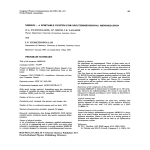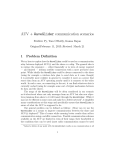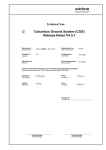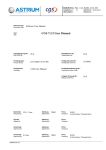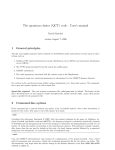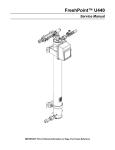Download Hurwitz Interconnect Delay Evaluation
Transcript
Hurwitz Interconnect Delay Evaluation
Programmer’s Manual
Hurwitz Interconnect Delay Evaluation - HIDE
Programmer’s Manual
Zhanhai Qin
Chung-Kuan Cheng
VLSI Lab, Computer Science & Engineering Department
University of California, San diego
Nov. 18, 2000
1 of 23
Hurwitz Interconnect Delay Evaluation
Programmer’s Manual
Flow Chart
Start
Read command file
SPICE format
DSPF format
SPICE parser
DSPF parser
IsGenMoment ?
No
Yes
Moment Generation
BottomUp reduction
IsElmore ?
No
Yes
TopDown Expension
Elmore
Node Delay Evaluation
Output Waveform ?
No
Node_Eval
Yes
Hspice netlist file ?
No
HSPICE_Gen
Yes
End
2 of 23
Hurwitz Interconnect Delay Evaluation
Programmer’s Manual
Data Structure & Routines
Note: The functionality of the program is described in HIDE User’s manual.
All the macros, data structures, and global variables are defined in HIDE/inc/HDstruct.h.
Macros
# define NP 2
# define NM 4
# define MAXCOLUMN 100
# define MAXIT 10
# define XACC 1e-4
/* Define the number of poles */
/* Define the number of moment orders */
/* Define the maximal number of characters in any lines of an ASCII file */
/* Define the maximal number of iterations in Newton-Ralphson approach */
/* Define the error upper bound for Newton-Ralphson approach */
# define DRIVER_OUT
# define BRANCH
# define RECEIVER_IN
# define SINK
/* Define the positions of a test node in test-node list */
0
1
2
3
# define TBLSIZE 1024
/* Define the size of the Hash table to store nodes */
# define MAX(x1,x2) ... ...
# define MIN(x1,x2) ... ...
/* Get the maximum of x1 and x2 */
/* Get the minimum of x1 and x2 */
# define SQR(x) ... ...
# define CUBE(x) ... ...
/* Get x square */
/* Get x cube */
# define NewString(x,l) ... ...
/* Allocate an l long string to char-typed pointer variable x with initial values zero */
# define NEWNODE(x) ... ...
/* Allocate an node to NODEPTR-typed pointer variable x with initial values zero */
# define NEWTESTNODE(x) ... ... /* Allocate a new testnode to (TESTNODE *)-typed pointer variable x with initial
values zero */
# define NEWTABLE(x,y) ... ...
/* Allocate a hash table with y entries to NODEPTR-typed pointer variable x with initial
values zero */
# define STRCPY(x,y) ... ...
/* Allocate space for char-typed pointer variable x and copy the content in y into x */
3 of 23
Hurwitz Interconnect Delay Evaluation
Programmer’s Manual
Data structures
typedef struct rc{
Real r;
Real c;
}RC_Pair;
RC parameters from parent node to the current node. See NODE structure for
details.
typedef struct pi_model{
Real C1;
Real R;
Real C2;
}PI_Model;
Save π model parameters. Literally speaking, they are two capacitors and one
resistor.
typedef struct transfer_function{
Real a[2];
Real b[3];
}TranFun;
Save the coefficients of every transfer function. b[] is for denominator coefficients, and a[] is for numerator coefficients.
typedef struct two_pole{
Real a[2], b[3];
Real P[3], K[3];
}Two_Pole;
Save poles and residues in P[] and K[] respectively.
typedef struct admittance_coefficents{
Real y[4];
}Adm_Coeff;
Save the first four admittance coefficients.
4 of 23
Hurwitz Interconnect Delay Evaluation
Programmer’s Manual
typedef struct node{
/* Node information */
char * NID;
char * PID;
int
Nchild;
int
Nreduction;
struct node * parent;
struct node * child;
struct node * brother;
RC_Pair RC;
struct node * next;
/* Name of the node */
/* Name of the parent */
/* Number of the node’s Child(ren) */
/* Number of reduced branches of the node */
/* Parent ptr of the node*/
/* The first child ptr of the node */
/* The next brother ptr of the node */
/* RC Parameter from the parent to the present node; Load capacitance included*/
/* Used to link synonyms in Hash table*/
/* Reduction Parameter */
PI_Model Down_PI;
PI_Model Up_PI;
Adm_Coeff Down_AC;
Adm_Coeff Up_AC;
Two_Pole TP;
TranFun Up_TF;
/* π equivalent circuit of the downstream tree structure */
/* Reduced π equivalent circuit seen from the parent of the node */
/* Total Admittance Coefficients of the downstream tree structure*/
/* Admittance Coefficients seen from the parent of the node */
/* Two Pole Model*/
/* Transfer Function from the parent of the node*/
/* Parsed command lines */
Real
trstart;
Real
trend;
Real
tdelmore;
Real
td2m;
Real
td;
/* start point for rise time */
/* end point for rise time */
/* Elmore delay from source */
/* D2M delay */
/* 50% delay from the source to the present node */
/* For moment evaluation use */
Real
I;
/* Branch current */
Real
m[NM];
/* Saved nodal moments */
Real
Y[NM];
/* DownStream AC */
}NODE;
typedef NODE * NodePtr;
Node related information is saved in this data structure.
typedef struct signal{
char * func;
Real Vdd;
Real tr;
char * SrcNode;
NodePtr root;
}SIGNAL;
/* Specify the function name, exp, ramp, or step. */
/* Supply Voltage */
/* Rise time of the signal */
/* Name of the Source Node, e.g. IN */
/* root of the interconnect tree */
Input Signal information is saved in this data structure.
5 of 23
Hurwitz Interconnect Delay Evaluation
Programmer’s Manual
typedef struct stack{
NodePtr Pnode;
struct stack * NextPtr;
}Stk;
typedef Stk * StkPtr;
A stack structure used in RC bottom-up reduction.
6 of 23
Hurwitz Interconnect Delay Evaluation
Programmer’s Manual
Global variables
char * isDebug ;
/* Specify if the program is in debug mode or not */
char * isGenMoment ;
/* Specify if the program evaluates moments and outputs them */
char * isGenHspiceNetlist ;
/* Specify if the program needs to generate the equivalent Hspice netlist file */
char * isOutputWaveform;
/* Specify if the program outputs the waveform for test node(s) */
char * isElmore;
/* Specify if the program outputs Elmore delay for user-concerned node(s) */
char * isD2M;
/* Specify if the program outputs D2M delay for user-concerned node(s) */
char * FinFormat;
/* Specify the input netlist file format: spice or DSPF */
char * isOutputAll;
/* Specify if all nodes need to be printed out */
char * isRiseTime;
/* Specify if the program evaluates the rise time for user-concerned node(s) */
char * isUseDefaultTestNode;
/* Specify if test node list is default, or defined by users */
Real Vtdth;
/* Define delay threshold. A real number between 0.0 and 1.0 */
Real VtrStart;
/* Define output signal’s starting threshold. A real number between 0.0 and 0.5 */
Real VtrEnd;
/* Define output signal’s ending threshold. A real number between 0.5 and 1.0 */
FILE * Fin;
/* File handle of input netlist file */
FILE * Fout;
/* File handle of delay result output file */
FILE * Fspice;
/* File handle of Hspice-formatted input netlist file if needed */
int
Ntotal_node;
/* Number of all nodes */
int
Ntestnode;
/* Number of all test nodes */
TESTNODE * TestNode;
/* Head of test node list */
SIGNAL * Src;
/* Root of everything: input netlist, stimulus, etc. */
Real
tstep,tstop;
/* Step size and stop point of simulation time. Used in waveform evaluation *
int
Total_iter;
/* Newton-Ralphson iteration control */
NodeNameList * AssignedTestNodeName; /* Head of user-defined test node name list */
7 of 23
Hurwitz Interconnect Delay Evaluation
Programmer’s Manual
Subroutine Definitions
Please find the formal user-defined types in the section above.
Main.c
: controls the whole program flow.
Interface
: By including the header HDstruct.h.
Internal Routines
: Routines used within this module;
main
- main routine of the whole program, controlling the program running flow.
Referred External Routines : Routines defined outside to be used within this module;
ReadInput
- Given HIDE configuration file, configure run-time settings.
SPICE_Parser
- Given an input netlist file handle, returns StkPtr structure.
DSPF_Parser
- Given the input netlist file handle, returns StkPtr structure.
BottomUpReduction - Reduce a given RC tree into an equivalent RC PI circuit.
Driver_Eval
- Calculate a stable transfer function for driving point.
TopDownExpansion - Propagate transfer functions in a top-down fashion.
Elmore
- Given an node, evaluate Elmore delay for itself and its downstream nodes.
Moment
- Evaluate up to NM-th moments for the present node and its downstream nodes.
Delay
- Given the root of a netlist, evaluate the delay for all the nodes in the netlist.
TestNodeDelay
- Evaluate the delay for all the nodes in test node list.
Node_Eval
- Evaluate the output response for test nodes.
HSPICE_Gen
- Generate an HSPICE netlist file, which can be used for delay verification.
Data_Output
- Output customized delay results for each user-interested node.
Routine(s) : description for each routine in this file;
main ( argc, argv )
int
argc;
/* The number of arguments from Unix Shell */
char *argv[];
/* The argument strings from Unix Shell */
Usage : given HIDE configuration file from Unix Shell, return delay evaluation result.
Algorithm :
1. Check if the arguments from Unix Shell are in good format. Exit if they are not;
2. Call ReadInput() to parse the given HIDE configuration file;
3. Call SPICE_Parser() or DSPF_Parser() to parse the given input netlist file;
4. Call Moment() to evaluate nodal moments if needed;
5. Call BottomUpReduction() to reduce the given netlist;
6. Call Elmore() to evaluate nodes’ Elmore delay if needed;
7.
If Elmore() is not called, call Driver_Eval() and TopDownExpansion() to evaluate the driver and perform
TopDown Expansion for transfer function propagation;
8. Call Delay() or TestNodeDelay to evaluate delay for all nodes or only selected test nodes;
9. Call Data_Output() to print delay evaluation results into files;
10. Call Node_Eval() to evaluate nodes’ delay waveform if needed;
11. Call HSPICE_Gen() to generate equivalent HSPICE netlist file if needed.
8 of 23
Hurwitz Interconnect Delay Evaluation
ReadInput.c
: parses the given HIDE configuration file.
Interface
: By including the header HDstruct.h.
Programmer’s Manual
External Routines : Routines defined here to be used outside;
ReadInput - given HIDE configuration file, configure run-time settings.
Macros : macros used within this module;
NewNodeNameList(x) - allocates a NodeNameList structure to pointer variable x.
Routine(s) : description for each routine in this file;
void ReadInput ( Finitial)
FILE *Finitial;
/* Handle of the given HIDE configuration file */
Usage : Given the file handle, configure HIDE run-time settings.
Algorithm :
1. retrieve ASCII strings line by line from Finitial;
2. parse each line by assigning a value to the corresponding run-time setting variable(s)
Parser.c
: parses the given input netlist file in SPICE format.
Interface
: By including the header HDstruct.h.
External Routines : Routines defined here to be used outside
SPICE_Parser - given the input netlist file handle, returns a well-filled StkPtr structure.
Internal Routines
: Routines used within this module
Parse_spice - given the input netlist file handle, returns a well-filled Src structure.
Referred External Routines : Routines defined outside to be used within this module;
Hash
- map an node name to a hash table entry;
InsertNode
- given an node name, insert the node into the Hash table;
SearchNode
- given an node name, return its entry ptr in the Hash table;
SortNode
- link entries in the Hash table and return the input node as root;
Find_Sink_Node
- build stack for later RLC reduction;
Display_Node
- print out all the node in the Hash table (debug use);
Display_Sink_Node - print out all the nodes in the stack (debug use);
Routine(s)
void SPICE_Parser ( Fin, StkTop )
FILE *Fin;
/* Handle of the given input netlist file */
StkPtr *StkTop;
/* Top pointer of the stack containing all the nodes */
Usage : Given input netlist file handle, returns the top entry pointer of node stack StkTop.
Algorithm :
1. Call Parse_spice() to parse input netlist file and build the structure Src;
2. Call Find_Sink_Node() to push all nodes into StkTop in bottom-up fashion;
3. If program is in Debug mode, call Display_Node() and Display_Sink_Node() to show retrieved nodal
information in Src structure and StkTop structure, respectively.
9 of 23
Hurwitz Interconnect Delay Evaluation
Programmer’s Manual
int Parse_spice ( Fin, Src )
FILE
*Fin;
/* Handle of the given input netlist file */
SIGNAL *Src;
/* Structure with all circuit and stimulus information */
Usage : Given input netlist file handle, parse the file and returns Src structure.
Algorithm :
1. Skip empty and commented lines if any;
2. Allocate Hash table with TBLSIZE entries to TblHead;
3. Resistor definitions, Capacitor definitions, Independent voltage source definitions, .tran statements, and .print
statements will be identified and parsed using a switch statement. Insert if the second node in Resistor
definition is not in TblHead yet; also insert if the first node in Capacitor definition is not in TblHead yet. Link
lists will be used as an solution to HASH confliction. Meanwhile, Src->Vdd, Src->tr, tstep, and tstop global
variables will be assigned. Global variable TestNode will be updated if there is any .print statements. On the
presence of .end statement, call SortNode() to link all the nodes in the Hash table and routine returns 1.
DSPF_Parser.c
: parses the given input netlist file in DSPF format.
Interface
: By including the header HDstruct.h.
External Routines : Routines defined here to be used outside
DSPF_Parser
- given the input netlist file handle, returns StkPtr structure;
Hash
- map an node name to an hash table entry;
InsertNode
- given an node name, insert the node into the Hash table;
SearchNode
- given an node name, return its entry ptr in the Hash table;
SortNode
- link entries in the Hash table and return the input node as root;
Find_Sink_Node - build stack for later RLC reduction;
Traverse_tree
- traverse the whole tree in prefix order, label nodes if necessary;
Display_Sink_Node - print out all the nodes in the stack (debug use);
Display_Node
- print out all the node in the Hash table (debug use);
Push_Stk
- create an node and push it into the stack;
Pop_Stk
- free the top node in the stack and return its Pnode field value.
Internal Routines
: Routines used within this module
Parse_dspf - given the input netlist file handle, returns well-filled Src structure.
Routine(s)
void DSPF_Parser ( Fin, StkTop )
FILE *Fin;
/* Handle of the given input netlist file */
StkPtr *StkTop;
/* Top pointer of the stack containing all the nodes */
Usage : Given input netlist file handle, returns the top entry pointer of node stack StkTop.
Algorithm :
1. Call Parse_dspf() to parse input netlist file and build the structure Src;
2. Call Find_Sink_Node() to push all nodes into StkTop in bottom-up fashion;
3. If program is in Debug mode, call Display_Node() and Display_Sink_Node() to show
information in Src structure and StkTop structure respectively.
retrieved nodal
int Parse_dspf ( Fin, Src )
10 of 23
Hurwitz Interconnect Delay Evaluation
FILE
*Fin;
SIGNAL *Src;
Programmer’s Manual
/* Handle of the given input netlist file */
/* Structure with all circuit and stimulus information */
Usage : Given input netlist file handle, parse the file and returns Src structure.
Algorithm :
1. Skip empty and commented lines if any;
2. Allocate Hash table with TBLSIZE entries to TblHead;
3. Resistor definition lines, Capacitor definition lines, and interface node definition lines (starting with X...) will
be identified and parsed using a switch statement. Insert if the second node in Resistor definition lines is not
in TblHead yet; also insert if the first node in Capacitor definition lines is not in TblHead yet. Link lists will
be used as an solution to HASH confliction. Global variable TestNode will be defined using output nodes (the
nodes with names starting with ‘O’) if there is any X... statement. On the occurrence of .ends statement, call
SortNode() to link all the nodes in the Hash table and routine returns 1.
void Traverse_tree ( root )
NodePtr root;
Usage : Given an root node as input, all the downstream nodes will be visited in prefix order.
Algorithm :
1. call Traverse_tree recursively. Return if root = Null;
2. If root has no child, create a new test node with StateVar labeled as SINK and insert the test node into global
variable TestNode, which is a test node list;
3. If root has only one child, nothing will be done but call Traverse_tree(root->child);
4. If root has more than one child, create a new test node with StateVar labeled as BRANCH and insert the test
node into global variable TestNode, which is a test node list;
5. After visiting all the child(ren), if any, call Traverse_tree(root->brother) to visit its brothers.
NodePtr SortNode ( TblHead )
NodePtr TblHead;
/* point to the first entry of the Hash table */
Usage : Link entries in the Hash table into a tree structure and return the root of the tree.
Algorithm :
1. For every nonempty entry in the Hash table, label it as root if it has no parent (PID field is NULL). Otherwise
call SearchNode() to find its parent entry in the Hash table and make its parent field point to that entry. Also
update the parent’s child field at the same time.
int Hash ( name )
char *name;
/* Node name as input */
Usage : Given an node name as input, apply an Hash function and return the value.
Algorithm :
1. s = 1 and k = strlen(name) - 1;
2. Hash function: for i = 0 to k s = 2 * (s + (*(name + i)))
11 of 23
Hurwitz Interconnect Delay Evaluation
Programmer’s Manual
NodePtr InsertNode ( TblHead, name )
NodePtr *TblHead;
/* point to the first entry of the Hash table */
char
*name;
/* Node name */
Usage : Given an node name, insert the node into the Hash table;
Algorithm :
1. Call Hash() to get an Hash entry i;
2. If ith entry in the Hash table is empty, copy name to NID field of the entry;
3. Otherwise create a new node, copy name to NID field of the node, and insert the node into the link list of the
ith entry;
4. Newly created node or the ith entry will be returned.
NodePtr SearchNode ( TblHead, name )
NodePtr *TblHead;
/* point to the first entry of the Hash table */
char
*name;
/* Node name */
Usage : given an node name, return its entry ptr in the Hash table. The ptr could point to an node in a Hash entry list.
Algorithm :
1. Call Hash() to get an Hash entry i;
2. If the ith entry is empty, return NULL;
3. Otherwise if the ith entry’s NID = name, return the ith entry ptr;
4. Otherwise search through the ith entry’s link list, return NULL if name is not matched, and return the node
ptr if name is matched.
void Find_Sink_Node ( TOP, StkTop )
NodePtr TOP;
/* the root of the netlist in the Hash table */
StkPtr StkTop;
/* the top of the stack */
Usage : Traverse the tree and push every node into the stack in an bottom-up fashion.
Algorithm :
1. If TOP is not a sink node, apply Find_Sink_Node on each of its children;
2. Otherwise push this sink node (TOP) into the stack by calling Push_Stk().
Push_Stk ( StkTop, Ptr_Node)
StkPtr *StkTop;
/* top of the stack */
NodePtr *Ptr_Node;
/* ptr of the node going to be pushed in */
Usage : Given the top of the stack and the node ptr which is going to be pushed in, do push action on the stack and
return the updated top ptr.
Algorithm :
1. Create an Stk structure;
2. Link its Pnode field to Ptr_Node;
3. Update StkTop.
12 of 23
Hurwitz Interconnect Delay Evaluation
Programmer’s Manual
NodePtr Pop_Stk ( StkTop )
StkPtr *StkTop;
/* top of the stack */
Usage : free the top node in the stack and return its Pnode field value.
Algorithm :
1. Return the StkTop->Pnode;
2. Update *(StkTop) and free the original Stk structure.
void Display_Sink_Node ( StkTop )
StkPtr *StkTop;
/* top of the stack */
Usage : Traverse all the nodes in the stack and print them out.
Algorithm :
1. From the top to the bottom of the stack, print out every entry’s Pnode->NID, Pnode->RC.r, Pnode->RC.c.
Display_Node ( TOP )
NodePtr TOP;
/* top of the stack */
Usage : Recursively traverse all the nodes in the Hash table in prefix order and print them out.
Algorithm :
1. If TOP is an sink node, print out TOP->NID, TOP->RC.r, and TOP->RC.c and return;
2. Otherwise if TOP has child(ren), print out TOP->NID, TOP->RC.r, and TOP->RC.c and apply
Display_Node on each of its children.
Moment.c
: Evaluate moments for each node in the netlist.
Interface
: By including the header HDstruct.h.
External Routines : Routines defined here to be used outside;
Moment - evaluate up to NM-th moments for the present node and its downstream nodes.
Internal Routines
: Routines used within this module;
Moment_Cal
- Evaluate the ith order moment of a node and its downstream nodes;
DownStreamCurrent - Evaluate the ith order branch current of a node.
Routine(s)
void Moment ( Node )
NodePtr Node;
Usage : Given an node ptr, evaluate up to NM-th moments for itself and all the downstream nodes.
Algorithm :
1. i = 0;
2. Call DownStreamCurrent() to calculate ith order branch current of Node;
3. Call Moment_Cal() to calculate the ith moment of Node;
4. Repeat 2 and 3 until i = NM.
13 of 23
Hurwitz Interconnect Delay Evaluation
Programmer’s Manual
void Moment_Cal ( Node, i)
NodePtr Node;
/* node to be evaluated */
int i;
/* ith moment to be evaluated */
Usage : Given an node ptr and integer i, evaluate the ith order moment of the node itself and its downstream nodes.
Algorithm :
1. AWE approach to evaluate moments. Moments are evaluated in a top-down (root to leaves) fashion.
void DownStreamCurrent ( Node, i)
NodePtr Node;
/* node to be evaluated */
int i;
/* ith moment to be evaluated */
Usage : Given an node ptr and integer i, evaluate the ith order branch current, which is the sum of all downstream
currents and current from its capacitor.
Algorithm :
1. AWE approach is used here. Branch currents are evaluated in a bottom-up (leaves to root) fashion.
RC_Reduction.c
: Do hierarchical tree reduction.
Interface
: By including the header HDstruct.h.
External Routines : Routines defined here to be used outside
BottomUpReduction - Reduce the given RC tree into an equivalent RC PI circuit.
Internal Routines
: Routines used within this module
Series_Reduction - Reduce an RC segment with a PI load into one equivalent PI load;
Branch_Mergence - Merge all downstream PI loads into one equivalent PI load.
Referred External Routines : Routines defined outside to be used within this module;
Push_Stk - create an node and push it into the stack;
Pop_Stk - free the top node in the stack and return its Pnode field value.
Routine(s)
void BottomUpReduction ( StkTop )
StkPtr * StkTop;
Usage : Given the top of the stack, do bottom-up RC reduction. As a result, every node’s Up_AC, Down_AC, Up_PI,
Down_PI, Up_TF fields will be updated.
Algorithm :
1. Call Pop_Stk() to get the top node. Routine ends if the node is Src->root;
2. Do backward RC reduction on this node by calling Series_Reduction() until the branch root occurs;
3. Check if all the children of the branch root have been reduced. If not, go back to step 1;
4. Otherwise call Branch_mergence() to merge all the branches of the branch root and push the merged
equivalent node into the stack. Go back to step 1.
14 of 23
Hurwitz Interconnect Delay Evaluation
Programmer’s Manual
void Series_Reduction ( Nodel1, Node0 )
NodePtr Node1;
/* the former node in the series */
NodePtr Node0;
/* the latter node in the series */
Usage : Given two serialized lumped segments, reduce them into a new PI load.
Algorithm : [1]
1. Use Node0’s admittance coefficients to evaluate Node1’s admittance coefficients;
2. Realize the elements of the new PI load;
3. Evaluate a stable transfer function for Node1 from realized reduction.
void Branch_Mergence ( Node )
NodePtr Node;
Usage : Given an node ptr, merge all its branches into a new PI load.
Algorithm :
1. Sum up every branch node’s ith admittance y[i], which is Node’s ith admittance y[i];
2. Realize the elements of the new PI load.
DELAY.c
: calculate node delay.
Interface
: By including the header HDstruct.h.
External Routines
Delay
TestNodeDelay
Elmore
Internal Routines
Delay_Cal
V_dV
Td_ini
Search_Node
Newton_Ralphson
: Routines defined here to be used outside
- Given the root of a netlist, evaluate the delay for all the nodes in the netlist.
- Evaluate the delay for all the nodes in test node list.
- Given an node, evaluate Elmore delay for itself and its downstream nodes.
: Routines used within this module
- Given an node, evaluate the 50% delay of it.
- Given time t, evaluate V and dV for the given node at that moment.
- Given an node ptr, return the initial value for its delay.
- Given an node ptr and an node ID, try to find if the node is in the subtree with Top as
root.
- A well-know approach to solve nonlinear equations. Given a root boundary and equation
forms, root will be returned.
Routine(s)
void Delay ( Node )
NodePtr Node;
Usage : Given the root of a netlist, evaluate the delay for all the nodes in the netlist.
Algorithm :
1. Call Delay_Cal() to evaluate the delay of the root;
2. Apply Delay() recursively on the root’s children.
void TestNodeDelay ()
15 of 23
Hurwitz Interconnect Delay Evaluation
Programmer’s Manual
Usage : Evaluate the delay for all the nodes in test node list.
Algorithm :
1. If IsUseDefaultTestNode setting is “no” in HIDE configuration file, build test node list TestNode from the test
node list given in the configuration file;
2. Apply Delay_Cal() on each node in the list.
void Delay_Cal ( node )
NodePtr node;
Usage : Given an node, evaluate the 50% delay of it.
Algorithm :
1. If the parent node delay is available, use that value as the delay boundary of the present node’s delay; otherwise call Td_ini() to get the boundary;
2. Call Newton_Ralphson() method to evaluate the node delay;
3. If isRiseTime setting is “yes” in HIDE configuration file, call Newton_Ralphson() method to evaluate the
starting point delay and the end point delay.
void Elmore ( Node )
NodePtr Node;
/* node for Elmore delay evaluation */
Usage : Given an node, evaluate Elmore delay for itself and its downstream nodes.
Algorithm :
1. If Node is an sink node and it is not the child of the root, evaluate its Elmore delay = parent Elmore delay +
Node->RC.r * (Node->Rc.c + downstream capacitors) and return;
2. If Node is the child of the root, Elmore delay = Node->RC.r * (Node->Rc.c + downstream capacitors);
3. If Node is not an sink node, nor the child of the root, Elmore delay = parent Elmore delay + Node->RC.r *
(Node->Rc.c + downstream capacitors);
4. Apply Elmore() on each of its children.
void V_dV( t, V, dV, node, Vth, Order )
Real
t;
Real
*V;
Real
*dV;
NodePtr
node;
Real
Vth;
int
Order;
Usage : Given time t, evaluate V and dV for the given node at that moment.
Algorithm :
1. Due to different input signal forms, three branches are used to evaluate V and dV at the given moment. Basically, the method we use is symbolic formula, which is equivalent to convolution. However, we don’t have to do
convolution since it is very expensive (O(n^2)) and our input signals are step, ramp or exponential functions only,
we can use symbolic formula to do in O(1) time.
16 of 23
Hurwitz Interconnect Delay Evaluation
Programmer’s Manual
Real Td_ini ( Node )
NodePtr Node;
Usage : Given an node ptr, return the initial value for its delay.
Algorithm :
1. Apply D2M approach to initialize the node’s delay value.
NodePtr Search_Node ( Top, NodeNumber )
NodePtr Top;
char
*NodeNumber;
Usage : Given an node ptr and an node ID, try to find if the node is in the subtree with Top as root.
Algorithm :
1. Traverse the subtree with Top as root, and return the node ptr if the node with the name NodeNumber is found
in this subtree, otherwise NULL is returned.
Real Newton_Ralphson ( x1, x2, Xacc, f_df, Vth, node, Order )
Real
x1;
Real
x2;
Real
Xacc;
void (*f_df) (Real, Real *, Real *, NodePtr, Real, int);
Real
Vth;
NodePtr node;
int
Order;
Usage : A well-know approach to solve nonlinear equations. Given a root boundary and equation forms, root will be
returned.
Algorithm :
1. Use bisection method to refine the given root boundary;
f ( x)
2. Newton-Ralphson formulation: ϕ ( x ) = x – -----------′
f (x)
Pole_Eval.c
: Evaluate poles for each node.
Interface
: By including the header HDstruct.h.
External Routines : Routines defined here to be used outside
Driver_Eval - Calculate a stable transfer function for driving point.
TopDownExpansion
Internal Routines
: Routines used within this module
AdjacentNodeExpansion
PoleResidueEval
Hier_Moment
17 of 23
Hurwitz Interconnect Delay Evaluation
Programmer’s Manual
Routine(s)
void Driver_Eval ( )
Usage : Calculate a stable transfer function for driving point.
Algorithm : [1]
1. Please refer to reference [1] and Series_Reduction ().
void TopDownExpansion ( node )
NodePtr node;
Usage : Propagate the transfer function from driver node to all the sink nodes, and meanwhile every node’s poles
will be evaluated.
Algorithm :
1. Call AdjacentNodeExpansion (node, node->child) to expand the transfer function from node to node->child;
2. Call TopDownExpansion (node->child) to recursively expand the transfer function;
3. If node still have children untouched , go back to step 1.
void AdjacentNodeExpansion ( node0, node1 )
NodePtr node0;
NodePtr node1;
Usage : Given upstream node node0 and downstream node node1, evaluate transfer function for node1.
Algorithm : [1]
1. Refer to Theorem 2 of reference [1] on how to merge two transfer functions, keeping it Hurwitz stable.
void PoleResidueEval ( node )
NodePtr node;
/* node to evaluate poles and residues */
Usage : Given an node ptr, evaluate poles and residues of its transfer function.
Algorithm :
1. Given transfer function and admittance coefficients, it is easy to evaluate poles of the transfer function and
also the residue. Depending on the polynomial order of the denominator, poles can be obtained with closed forms
or by calling RealPole(), which uses Newton Ralphson method. Currently the program is using 2-pole model, so
RealPole() is not used yet.
void Hier_Moment ( node )
NodePtr node;
Usage : Given an node ptr, compute moments locally.
Algorithm :
1. Arbitrary order of the moments can be trivially obtained because we know the transfer function of the node.
Just do fraction division.
18 of 23
Hurwitz Interconnect Delay Evaluation
Data_Output.c
: output delay, risetime, Elmore delay or moments if needed.
Interface
: By including the header HDstruct.h.
Programmer’s Manual
External Routines : Routines defined here to be used outside
Data_Output - Output customized delay results for each user-interested node.
Internal Routines
: Routines used within this module
OutputAll
- Output customized delay results for each node;
OutputTestNode - Output delay and rise time for each test node.
Routine(s)
void Data_Output ( )
Usage : Output customized delay results for each node or just delay and rise time for each test node.
Algorithm :
1. Due to the setting “isOutputAll” from HIDE configuration file, call OutputAll() or OutputTestNode()
respectively.
void OutputAll ( Node )
NodePtr Node;
Usage : Given an node ptr, output customized delay results for this node.
Algorithm :
1. If “isElmore” is set as “yes”, output Elmore delay; otherwise output HIDE delay.
2. If “isD2M” is set as “yes”, output D2M delay;
3. If “isGenMoment” is set as “yes”, output its 0th to NMth moments;
4. Apply OutputAll on each of its children.
void OutputTestNode ( )
Usage : Output delay and rise time for each node in the test node list.
Algorithm :
1. Output delay for test node i;
2. If “isRiseTime” is set as “yes”, output its rise time as well;
3. i becomes the next node in the test node list, until all the test nodes are visited.
TDWE.c
: Time domain waveform evaluation.
Interface
: By including the header HDstruct.h.
External Routines : Routines defined here to be used outside
Node_Eval - evaluate the output response for test nodes.
Internal Routines
: Routines used within this module
F2T - transfer the output response from frequency domain to time domain.
19 of 23
Hurwitz Interconnect Delay Evaluation
Programmer’s Manual
Routine(s)
void Node_Eval ( )
Usage : evaluate the output response for test nodes.
Algorithm :
1. Apply F2T() on each test node.
void F2T ( node, Order )
NodePtr node;
int
Order;
Usage : evaluate the node output waveform from 0.0 sec till tstop.
Algorithm :
1. We use the same approach - symbolic formula, which we use in V_dV().
HSPICE_GEN.c
: generate a HSPICE file for delay verification.
Interface
: By including the header HDstruct.h.
External Routines : Routines defined here to be used outside
HSPICE_Gen - generate an HSPICE netlist file, which can be used for delay verification.
Internal Routines
: Routines used within this module
write_Hspice - write RC netlist.
Routine(s)
void HSPICE_Gen ( Top )
NodePtr Top;
/* root of the netlist */
Usage : Given the root ptr of the netlist, generate an equivalent HSPICE netlist file.
Algorithm :
1. Write the root’s RC values in HSPICE file;
2. Call write_Hspice() to write RC netlist in HSPICE file;
3. Write stimulus information in HSPICE file;
4. Write test node in HSPICE file (.print...).
void write_Hspice ( Node, Fspice )
NodePtr Node;
FILE
*Fspice;
Usage : Given the root of the netlist and HSPICE handle Fspice, write RC netlist in HSPICE file.
Algorithm :
1. Write Node’s RC values in Fspice;
2. Apply write_Hspice on each of Node’s children.
20 of 23
Hurwitz Interconnect Delay Evaluation
Function_Lib.c
: define common routines.
Interface
: By including the header HDstruct.h.
Programmer’s Manual
External Routines : Routines defined here to be used outside
Error_exit - Print an error message corresponding to the given error code and exit;
OpenFile - Given a file name and open mode, return the file handle;
PrintUssage - Print usage information.
Routine(s)
void Error_exit ( Error_Code )
Usage : Given an error code, print out the corresponding error message and program exits.
FILE * OpenFile ( file, attribute )
char * file;
/* given file name */
char * attribute;
/* open file mode */
Usage : Given the file name and requested open mode, open the file and return the handle. Program will exit if file is
not found.
void PrintUssage ( )
Usage : Call to print the helpful information on how to run HIDE.
Timer.c
: evaluate program’s running time.
External Routines : Routines defined here to be used outside
BeginTiming - Start clock;
EndTiming - End clock and return how much time the clock run.
Macros : macros used within this module;
#define MAXClockNum 5 /* Control the maximal number of clocks allowed simultaneously */
Variables : variables only used throughout this module;
struct rusage ru[MAXClockNum];
/* system resource usage statistics */
struct timeval start_time[MAXClockNum];
/* start time of each clock */
struct timeval end_time[MAXClockNum];
/* end time of each clock */
Routine(s)
void BeginTiming ( i )
int i;
/* clock ID */
Usage : Given a clock ID, start a clock and identify it using the ID.
21 of 23
Hurwitz Interconnect Delay Evaluation
Programmer’s Manual
double Endtiming ( i )
int i;
/* Clock ID */
Usage : given a clock ID, end the clock and return how much time the clock run.
22 of 23
Hurwitz Interconnect Delay Evaluation
Programmer’s Manual
References
[1] Xiao-Dong Yang, C.K. Cheng, “Hurwitz Stable Reduced Order Modeling for RLC Interconnect Tree”, IEEE/ACM ICCAD, Nov. 2000, p.p. 222-8.
[2] L. T. Pilage, R. A. Rohrer, “Asymptotic Waveform Evaluation for Timing Analysis”, IEEE
Trans. on CAD, Apr. 1990, vol 9, p.p. 352-66.
23 of 23























